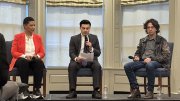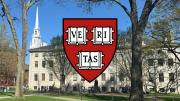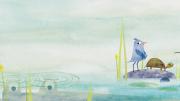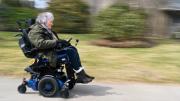For John Updike ’54, Litt.D. ’92, visiting museums is not a chore but a pleasure, one that brings back fond early memories of trips to the Reading (Pennsylvania) Museum with his mother. As the writer makes clear in hisbarelyfictional 1967 story “Museums and Women,” he finds museums endlessly fascinating, even sexy. Their galleries bring to his mind not the coldness and anonymity some visitors describe, but rather the warmth and beauty of specific objects he has admired, and of the women who have frequently accompanied him.
Updike graduated summa cum laude from the College. He edited the Lampoon and, not surprisingly, concentrated in English. But he also took two courses in the fine arts, and in one of them met the woman who later became his first wife. She was a Radcliffe fine-arts major who wore tattered sneakers in the snow and spoke about art with a “careless authority” that Updike envied. Together they visited the Fogg, which has never been better described: “It was, as museums go, rather intimate. Architecturally, it was radiantly hollow, being built around a skylight-roofed replica of a sixteenth-century Italian courtyard.” Far down a corridor he found the Wertheim Collection, and was delighted with the “Cézannes and Renoirs that, because they were rarely reproduced in art books, had the secret sweetness of flowers in a forest.”
|
Updike is thus no Johnny-come-lately when it comes to writing about art. The best satirical description of a blustering, boastful collector and his collection in all of literature can be found in Updike’s novel The Witches of Eastwick (1984). The inventor Darryl Van Horne (brilliantly played in the movie by Jack Nicholson) booms to his guest, “Now here’s the room I wanted you to see. La chambre de résistance!” Updike describes it: “On the walls of this long room, once hung with Lenox family portraits, there now hung or protruded or dangled gaudy travesties of the ordinarygiant pay telephones in limp canvas, American flags duplicated in impasto, oversize dollar bills rendered with deadpan fidelity, relentless enlargements of our comic strips….” Van Horne himself “gloated, snorted, and repeatedly wiped his lips” as he showed his guest around, and he explained, “When this Pop came along, I thought, Jesus, this is the stuff for me.”
Besides frequently making use of art in his novels and short stories, Updike has for most of his career also written thoughtful reviews of art exhibitions and their catalogs. In 1989 Knopf published Just Looking, a collection of the writer’s appraisals of exhibitions devoted both to European (Vermeer, Degas, Cézanne) and to American (Sargent, Erastus Salisbury Field) painters, many of which were initially prepared for the New Yorker. Now Knopf has published a second, companion volume entitled Still Looking, this one devoted to Updike’s essays from 1990 to 2004 on American art alone. Most of these were originally found in the New York Review of Books.
In many ways, Updike is the ideal museumgoer, a curator’s dream come true. He approaches every exhibition with an open mind, but optimistically; he studies the paintings with great care, thinking about everything from their brushwork to their broader meaning; he peruses the wall labels, and he takes in the wall colors and the layout. Next, unlike most visitors, he goes home and reads every word of the catalog. Then out comes his review, fluently written and cogently argued, a considered amalgam of what he has learned from the catalog and what his own eyes tell him. This is where curators may start to hate him, for he tells the story of the exhibition in a few fluent pages, without speaking down to his reader, in a way that scholars can only envy.
Updike could never win tenure at a major university. He eschews footnotes, while quoting liberally from the book under consideration. He never employs jargon, but writes as if conversing with a bright but uninformed friend. He never asks works of art to do things they cannotto right social wrongs, for exampleand he rarely mentions race or class or gender. Worse, he clearly enjoys museums and loves art, frequently speaking of beauty, quality, and other concepts that have been derided in academe since the late 1970s. Despite all of his experience with art criticism, Updike somehow remains a layman, the perfect amateur, the Everyman of museumgoers. Updike’s beat is the East Coast; he’s frequently in New York at the Met, MoMA, or the Whitney, but he treks off to Washington, Philadelphia, and Boston as well. He has returned to the Fogg only once, it seems, to prepare a long, carefully considered review of our print show of 2000, Dürer’s Passions, for the New York Review of Books.
Still Looking leads with a rare, crossover piece, a perceptive essay on “The American Face” that Updike prepared for a National Portrait Gallery exhibition catalog; many more museum publications and his amateur status will be endangered. In the book one also finds two reviews of big, thematic exhibitions: The American Sublime, the nineteenth-century landscape show organized by the Tate Gallery, which he liked, and American Impressionism and Realism at the Met, which he (rightly, I believe) found badly marred by its overlong, “hectoring” wall labels. Regarding the show’s treatment of the realist John Sloan, Updike complains, “The captious wall-captions, more integral to the show than the fuller sociological indictments of the catalogue, are obsessed by what Sloan does not depict.” He doesn’t object to descriptive labels, but he has an old-fashioned belief that interpretive materials should explicate the art, rather than subject it to contemporary political sensibilities.
Reviewing one-artist shows is Updike’s specialty, especially the large retrospectives that have become a staple of our museums’ offerings. Still Looking includes 15 such pieces, dedicated mostly to painters ranging from John Singleton Copley in the eighteenth century to Jackson Pollack and Andy Warhol in the twentieth, though it also includes one on photographer Alfred Stieglitz and another on a sculptor, Elie Nadelman. Updike is particularly good on Martin Johnson Heade, the nineteenth-century landscape and still-life painter, and he rightly rejects the argument in the Met’s “pretty catalogue,” as he calls it, that Heade’s paintings of thunderstorms reflect the painter’s and the nation’s stress caused by the Civil War.
Updike has a way with words. He is at his very best with Edward Hopper (commenting that “Hopper’s young females in these paintings are not yet aware of their poignance”) and, surprisingly, with Warhol (“[T]here is an uncanny, unearthly beauty and rightness to his work”). He suggests that Heade was “the first to portray a modern mood, an ambivalent mood tinged with dread and yet imbued with a certain lightness.” He dares observe, speaking of Thomas Eakins’s much admired rowing scenes, “an odd melancholy in these moody, scrupulous canvases,” and he concludes that Arthur G. Dove was “a pioneer of abstract painting but not one of its heroes.”
Updike struggles more with certain difficult painters, including Albert Pinkham Ryder and Marsden Hartley, but it is always an honest, transparent struggle. And when he finds chinks in the armor of the immortals, he doesn’t hesitate to say so. On Alfred Stieglitz: “It is hard to remember that he came from Hoboken, so Old World is the humorless absolutism of his pronouncements.” And on Whistler: “To think of Whistler’s nudes in relation to Degas’s, or his faces in relation to Sargent’s, is to confront an almost frightening lack of interest….”
I personally prefer reading Updike’s pieces in the New Yorker or the New York Review of Books to finding them anthologized on glossy paper and accompanied by numerous color illustrations, as we find in Still Looking. Somehow the articles feel more authentic to me in their original contexts. Still, it’s hard to begrudge their republication, especially as they will now doubtless find a far larger and more varied audience than before.
In the end, John Updike is a treasure. He loves art, he looks hard, and he has confidence in coming to his own conclusions. It’s hard to ask much more of a critic.
Theodore E. Stebbins Jr., J.D. ’64, Ph.D. ’71, was appointed in 2002 as the Harvard University Art Museums’ first curator of American paintings, and head of the new department of American art. He has taught at Harvard, Yale, Smith, and Boston University, and his voluminous writings on many aspects of American art include The Life and Works of Martin Johnson Heade.





